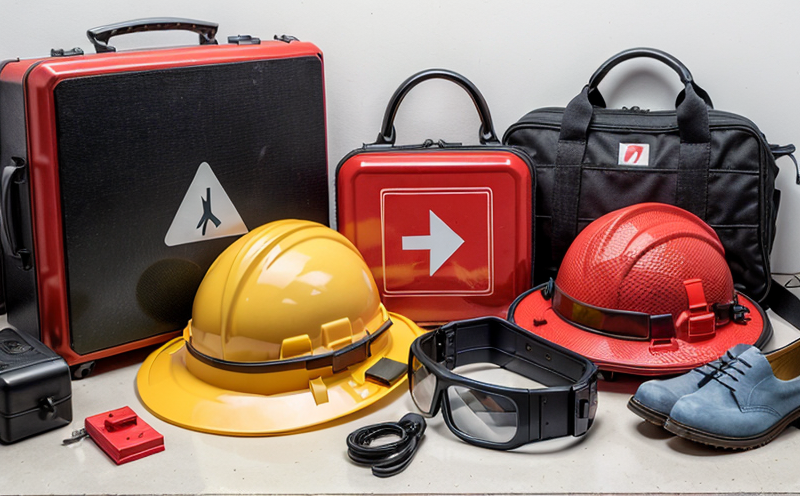EN 1869 Fire Blanket Flame Spread Assessment
The European Standard EN 1869 specifies a procedure to determine the flame spread characteristics of fire blankets. This standard is crucial for ensuring that fire blankets can effectively perform their intended function in emergency scenarios, thereby protecting lives and property. The test evaluates how quickly heat and flames spread across the surface of the blanket when exposed to an open flame.
The fire blanket is a critical piece of equipment used by firefighters and first responders during emergencies. It provides rapid cooling by absorbing radiant heat from a fire source, which can help prevent burns and minimize injury to individuals in close proximity to fires. By assessing the flame spread characteristics according to EN 1869, manufacturers ensure their products meet the required performance levels under various conditions.
The test procedure outlined in EN 1869 involves placing a known size specimen of fire blanket on a specially designed stand, which is then exposed to an open flame for a specified duration. The rate at which flames spread across this area indicates its suitability as a fire barrier material. Compliance with this standard ensures that the product has been rigorously tested and meets all relevant requirements.
For quality managers responsible for ensuring compliance within their organizations, understanding EN 1869 is essential. It helps them make informed decisions about selecting appropriate suppliers who adhere to international standards like these. Similarly, compliance officers play a key role in maintaining regulatory adherence across departments by overseeing the implementation of such tests.
R&D engineers benefit from familiarity with this standard as they work on developing new materials or improving existing ones for use within fire blankets. They must ensure that any changes made do not compromise performance standards set forth by EN 1869 while also considering factors like cost-effectiveness and ease of manufacturing.
Procurement professionals need to be aware of these requirements when sourcing components from suppliers, ensuring they meet the necessary criteria before finalizing contracts. This knowledge enables them to specify exact specifications required in tender documents or purchase orders.
Applied Standards
The EN 1869 standard establishes clear guidelines for testing fire blankets' flame spread characteristics. It mandates specific procedures and apparatus to achieve accurate results, ensuring consistency across different laboratories performing these assessments. Compliance with this international standard provides assurance that the product meets stringent quality benchmarks.
For those involved in occupational safety & protective equipment manufacturing or procurement, knowing which standards apply can help streamline processes, reduce risks associated with non-compliance, and improve overall confidence in purchased products. Understanding how specific tests contribute to meeting broader regulatory requirements also supports better decision-making regarding investments in new technologies or facilities.
By aligning internal practices closely with established norms like EN 1869, organizations enhance their reputation among clients and stakeholders by demonstrating commitment to high standards of safety and reliability. This alignment fosters trust between partners and contributes positively towards achieving common goals related to worker protection and business success.
Customer Impact and Satisfaction
The implementation of EN 1869 testing procedures ensures that fire blankets are effective in real-world scenarios, providing peace of mind for end-users. When selecting suppliers or products based on this standard, customers can be assured they are purchasing items designed to meet rigorous safety standards.
For businesses operating in high-risk environments where rapid response is essential during emergencies, having reliable fire blankets that comply with EN 1869 means better preparedness and potentially saving lives. The confidence provided by meeting these standards translates into higher customer satisfaction levels overall.
Manufacturers who adhere strictly to the requirements set out in this standard not only meet regulatory expectations but also enhance brand reputation among buyers seeking dependable solutions for their needs. By prioritizing quality assurance through thorough testing according to EN 1869, they contribute significantly toward maintaining public trust and fostering long-term relationships with loyal customers.
The consistent application of these tests across multiple facilities ensures uniformity in results, making it easier for end-users to compare different products accurately. This consistency supports fair competition within the market place, allowing consumers to make informed choices about which brand best suits their requirements.
Use Cases and Application Examples
The EN 1869 fire blanket flame spread assessment is widely used in various sectors, including firefighting services, construction sites, industrial plants, and other locations where rapid cooling of flames could prevent severe injuries or fatalities. Here are some practical applications:
- Fabrication Shops: Workers handling hot metal or other hazardous materials may benefit from quick access to fire blankets during emergencies.
- Data Centers: Protecting sensitive equipment against accidental fires is critical, making fire blankets a valuable asset in such environments.
- Mining Operations: Underground mining operations pose unique challenges regarding safety; having reliable fire protection tools nearby can mean the difference between minor incidents and catastrophic events.
- Residential Communities: Homeowners and property managers increasingly recognize the importance of keeping fire blankets readily available for quick response to small fires before they escalate into larger blazes.
These examples illustrate just how versatile fire blankets can be in preventing injuries and damage caused by uncontrolled flames. By adhering strictly to EN 1869, manufacturers ensure that these products perform consistently across all intended applications.





